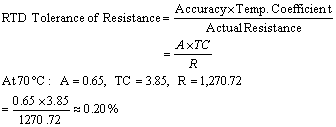|
|
Steve
Allison |
AutomatedBuildings.com
|
[an error occurred while processing this directive] |
|
|
Steve
Allison |
Which is better for commercial
HVAC/R applications, a thermistor or an RTD?
In order to make that determination, we need to look at the specifications
for each type of sensor. However, within the specifications, the words accuracy,
tolerance, and interchangeability can cause confusion. So, let's start by
defining each term:
|
|
|
|
|
|
|
|
|
|
|
|
|
|
|
[an error occurred while processing this directive] |
The challenge in comparing these two sensors is that thermistors are generally specified using accuracy and RTDs are generally specified using tolerance. This is done to put each sensor's "best foot forward". In order to truly compare thermistors to RTDs, we need to look at the same parameters for each. This "side by side" comparison of a standard BAPI thermistor and a standard BAPI RTD should prove enlightening.

10K-2 Thermistor
The accuracy for a thermistor is specified as ±0.2 °C over the commercial
temperature range (0 to 70 °C). Using an output table (resistance vs.
temperature), we find that this accuracy corresponds approximately to 333 ohms at 0
°C, and to approximately 12 ohms at 70 °C. We can then calculate the thermistor's
tolerance at both temperatures using the following equation:

[an error occurred while processing this directive]1K
(Class B) RTD
The initial tolerance for a 1K (Class B) RTD is specified as 0.12 % at 0
°C, this tolerance gets worse as the temperature moves away from 0 °C in
either direction. Using the following equation, we can calculate the
"Tolerance in °C" (accuracy) at both temperatures:

The accuracy at 70 °C can then be used to calculate the RTD's tolerance (of resistance) at this same temperature using the following equation:

So, what is the best sensor for the job?
As shown in the results chart above, our standard thermistor outperforms our
Class B RTD with respect to accuracy throughout the commercial temperature range
(0 °C to 70 °C). At the same time, our Class B RTD outperforms our standard
thermistor with respect to tolerance throughout the same range. Which
characteristic is most important? On the practical side, since RTDs have a
linear output with respect to temperature, they seem like they would be easier
to use. Is output linearity a problem?
In general for HVAC/R applications (where the goal is to maintain a certain temperature), a sensor's accuracy is considered most important. Also, today's DDC controllers are typically setup to handle thermistors, so a sensor's output linearity is not really an issue. Therefore, a thermistor would be the best choice in applications requiring a resistive sensing element by itself (no transmitter or transducer).
Please note, the dramatic improvement in thermistor accuracy and stability (less than 0.02 °C drift over ten years) is a fairly recent development. Over the last ten years, technological advances in the thermistor manufacturing process (very similar to the computer chip manufacturing process) and increasingly available raw materials have lead to more accurate, more stable, and lower cost thermistors. Similarly, technological advancements and falling prices within the computer chip industry have lead to controllers with increased RAM and faster processing speeds. These high power controllers can quickly and accurately read the thermistor's nonlinear output through extensive, detailed look up tables.
Is that the best we can do?
Both types of sensors are available in "high accuracy" models-XP
thermistors and Class A RTDs. These "high accuracy" models typically
cut the accuracy specification in half (±0.10 °C accuracy for XP thermistors
and 0.06% initial tolerance at 0 °C for Class A RTDs), but add to the cost of
the sensor. Additionally, the "accuracy" of an RTD can be improved by
matching it to a transmitter (calibrating the transmitter to the actual values
of the sensor at a given temperature reducing the RTD's initial tolerance of
resistance to zero). For example (as shown below), by selecting a span of 45 to
96 °F and using BAPI's matched sensor/transmitter pair we calculate a system
accuracy of ±0.435 °F (±0.242 °C)-an improvement over the initial accuracy
of ±0.3 °C for the RTD at 0 °C, but still not quite as good as the thermistor
alone.

Another option would be a dedicated, high accuracy sensor system or environment al monitor. This type of equipment is available in the market but is typically used for more specialized applications than commercial HVAC/R applications (like testing facilities or medical laboratories). This equipment is usually very expensive to buy and to maintain. In most cases, this type of sensor equipment would more accurate than needed, and would be cost prohibitive.
[an error occurred while processing this directive]
[Click Banner To Learn More]
[Home Page] [The Automator] [About] [Subscribe ] [Contact Us]